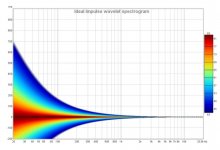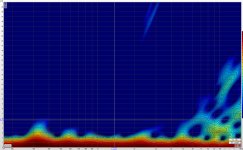Before doing this one should consider to study this history here (mentioned again): Home...Over 100 years of history in acoustic horns can be taken off the table,...
...the circle is closing...and the Keele paper I linked.
Interestingly one can read a lot about jmlc in the Kolbrek/Dunker book - a horn type which was rated here similar to vuvuzela sound and full of HOMs...
Btw, @camplo we are approaching 1 million hits not so far away... You mentioned your new 150Hz horn. I think we deserve to see your final solution?
camplo,
[...]
Does that answer your concerns about negative time area in CSD mode? The above graphs are from basically an ideal source. So every note is instant, no group delay and from zero to infinity Hz. (well almost)
I created that Dirac pulse with RePhase, and so could you. That could serve as study material and an the example of the illusive ideal.
Thank you for trying to help me understand...
If you look at the the Dirac...nothing is happening before 0ms...
What the heck is happening in the negative time space on the CSD! lol
Attachments
Last edited:
Yeah but do either of you understand the negative time area of the CSD in wavelet mode
What is being done here is to "expand" the impulse in a special set of functions. When these functions are wavelets, which are symmetric and get wider as the frequency gets lower then the wide wavelets get extended into the negative region - more and more as the freq goes lower. It is an artifact of the chosen set of functions (what is called the basis set.)
Any function can be expended into a set of basis functions, but there are rules for these functions.
Now if you chose a different set of functions, say damped (complex) exponentials, which are not symmetric (this set are called a Prony expansion,) this will not occur.
FYI, the Fourier transform basis set are sines and cosines of infinite extent, which leads to an altogether different artifacts to the expansion.
Maybe a bit too mathematical, but none the less, it is the answer.
Last edited:
Just to make sure I see you, full circle, I can literally ignore everything on the negative side of this view?
Yes, they are artifacts of the choice of expansion and have no physical reality.
I have never understood why people don't use the Prony techniques that I highlighted in an AES paper some two decades or so ago.
I have never understood why people don't use the Prony techniques that I highlighted in an AES paper some two decades or so ago.
Alright now! Ty you so much....
I think my assumption about Burst Decay beginning at peak energy is correct then, See Markkkk 🙄 at least in a general way.....a round about way...
Now my theory of pressure derived excess group delay needs some work.
There has to be enough crest and troughs vs amplitude attenuation time...for group delay to be heard. Which is why at higher frequencies, an amount of time, becomes more critical in the terms of time to peak energy.
I think my assumption about Burst Decay beginning at peak energy is correct then, See Markkkk 🙄 at least in a general way.....a round about way...
Now my theory of pressure derived excess group delay needs some work.
There has to be enough crest and troughs vs amplitude attenuation time...for group delay to be heard. Which is why at higher frequencies, an amount of time, becomes more critical in the terms of time to peak energy.
Last edited:
Yeah, it's not like the bass is already playing before the song starts (lol)
"where in the heck is the real 0 in time!" Should suggest to you that I knooooow something aint right.😀
Even if it was me.....Mmmmarkkkk lol!
Last edited:
ok my next theory....in real life acoustical events.... The first Crest of 20hz and 20khz can hit the ear....simultaneously....mind blown right?
Also, there are studies on the perception of group delay, but no studies to show the threshold of decay in loudspeaker systems? I would think that single note events would be the beginning of the test....this test would also have to take place in an anechoic chamber...
I know it was said that the decays get swamped but I think drivers like Ribbons, electro stats, etc, were known for transparency...They also have really great decay performance don't they. Are we really going to give all the credit to a smooth FR?
Also, there are studies on the perception of group delay, but no studies to show the threshold of decay in loudspeaker systems? I would think that single note events would be the beginning of the test....this test would also have to take place in an anechoic chamber...
I know it was said that the decays get swamped but I think drivers like Ribbons, electro stats, etc, were known for transparency...They also have really great decay performance don't they. Are we really going to give all the credit to a smooth FR?
Last edited:
"Also, there are studies on the perception of group delay, but no studies to show the threshold of decay in loudspeaker systems? I would think that single note events would be the beginning of the test....this test would also have to take place in an anechoic chamber..."
Hello Camplo
Sounds like ETC to me. The faster and cleaner the better.
Rob🙂
Hello Camplo
Sounds like ETC to me. The faster and cleaner the better.
Rob🙂
Last edited:
What exactly does ETC stand for?
etc acoustics - Google Search
Typing is not that hard you know 😉 🙄 🙂
(although this is why I don't like to speak to much in abbreviations in general)
I do agree that a compact impulse response is the goal. I don't like to see late arrival stuff and I worked very hard to minimize them. Basically this comes down to - primarily - the frequency response being flat. But occasionally one can detect small artifacts that have little influence on the FR, but can have a big effect on perception. At least that is what I have found.
I showed how the usage of foam in the waveguide decreased a small ripple in the impulse tail, while having little effect on the frequency response. I belief that this ripple was a late arriving HOM that was damped by the foam. There is a significant audible effect.
I showed how the usage of foam in the waveguide decreased a small ripple in the impulse tail, while having little effect on the frequency response. I belief that this ripple was a late arriving HOM that was damped by the foam. There is a significant audible effect.
- That part, I wanted to be able to say that this system is going to be an awesome tool for Eqing....in order to eq properly I need accurate perception of whats there.small artifacts that have little influence on the FR, but can have a big effect on perception
How bad did I do? Whats the bad news Doc....as they say
Attachments
I do agree that a compact impulse response is the goal. I don't like to see late arrival stuff and I worked very hard to minimize them. Basically this comes down to - primarily - the frequency response being flat. But occasionally one can detect small artifacts that have little influence on the FR, but can have a big effect on perception. At least that is what I have found.
I showed how the usage of foam in the waveguide decreased a small ripple in the impulse tail, while having little effect on the frequency response. I belief that this ripple was a late arriving HOM that was damped by the foam. There is a significant audible effect.
So it is in one sense it is still a FR problem, just a FR in a different point in time (later) for the "same" acoustical event (the stimuli). Its (almost) all in the FR...
//
Oh, that reminds me - is there a chapter on vuvuzela? I'd love to read that. That and a mole cricket burrow. All landmark achievements.[...] Interestingly one can read a lot about jmlc in the Kolbrek/Dunker book - a horn type which was rated here similar to vuvuzela sound and full of HOMs...
This is called "wrapping" where the phase appears to flip 180 instantly. This is done to make the phase more readable across the frequency range when there are reflections in the measurement. To see the measured phase you need to select unwrap phase, except then on any non gated measurement the phase will extended for 1000's of degrees and need to be zoomed out very far to see anything useful.There is one important thing being missed then....Phase being pushed forward in time...in real life....doesn't jump from one side of the chart to the other.....there is no time travel.
I can't count how many times I have thought the exact same thing.Why would anyone want to try to understand what you believe are your 'never before realized advanced discoveries', when it's so readily apparent to all that you don't have much of a grasp on the basic fundamentals of measurements?

Your style is to present nonsense as fact and learn from being shot down. This might work for you but it is unconventional and frustrating to those trying to help.I don't have any discoveries, I have theories and questions lol
If the impulse contains any acausal elements from linear phase filtering then they will still appear on the negative side as pre-ringing.Just to make sure I see you, full circle, I can literally ignore everything on the negative side of this view?
The Burst Decay plot is affected by the window and the time zero used in the settings.I think my assumption about Burst Decay beginning at peak energy is correct then, See Markkkk 🙄
Read the REW help files for any plot that you are looking as they contain a huge amount of good information that might help you work out some of the kinks for yourself.
Spectrogram Graph
The "crests" can not hit at the same time due to the differences in wavelength.ok my next theory....in real life acoustical events.... The first Crest of 20hz and 20khz can hit the ear....simultaneously....mind blown right?
- I looked for the setting, did not find it in the manual or in rew.time zero used in the settings.
- Home
- Loudspeakers
- Multi-Way
- Is it possible to cover the whole spectrum, high SPL, low distortion with a 2-way?

